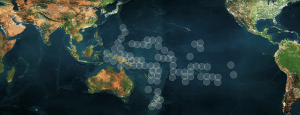[Via Satellite 05-14-2015] Kacific Broadband Satellites, an emerging satellite operator in the Asia-Pacific region, sees a huge opportunity to deliver satellite broadband to underserved remote communities of the Pacific islands, Indonesia, the Philippines, New Zealand and Papua New Guinea. With plans to launch the company’s first satellite around the end of 2016, Kacific has already signed six contracts — and the number is growing — to deliver more affordable broadband services to islanders, local businesses and collective systems in the region.
“If there is one place on Earth where broadband connectivity can be delivered by satellite and market opportunities still remain, it’s the Pacific Islands,” Christian Patouraux, CEO of Kacific Broadband Satellites, told Via Satellite. “In other markets satellite broadband is treated as a demand protection mechanism, paving the way for fiber. It’s difficult to develop an alternative business case in the Pacific.”
Patouraux told Via Satellite that the company plans to aggregate demand across a number of Pacific markets, with both small and large populations alike, offering bandwidth at speeds of up to 50 Mbps. As remote areas typically have populations with low incomes, one of the company’s main objectives is to keep costs down through both its business model as well as advancing tech. Kacific plans to adopt a “condo-satellite” business model, which is based on the real estate concept of condominiums. With the condo-sat model the company purchases, develops, and operates a geostationary satellite in association with another company and the two partners share the costs of the program while commercializing their own payloads separately.
Kacific also looks to use satellite technologies to deliver their services because they believe have been proven to be cost effective, such as Ka-band High Throughput Satellites (HTS), low power Very Small Aperture Terminals (VSATs), and WiMax within the communities.
The Kacific 1 satellite is scaled-down version of existing HTS and aims to serve more than 20 countries or separate archipelagos for a period of at least 15 years. The spacecraft will create a large number of narrow circular or shaped beams, each delivering 400 to 800 Mbps of Internet capacity, according to the company.
“The problem is that if you address individual markets one-by-one you cannot make a business case for building infrastructure. But by and large we’re not creating infrastructure in individual markets,” Patouraux explained. “A multi-beam satellite can serve a number of markets, aggregating demand and amortizing the costs over a much larger population. And low cost user-installable VSAT terminals mean that connecting a community is affordable.”
Plenty of other challenges come with servicing remote areas, where infrastructure and resources are scarce. Remote locations, lack of transport, electricity generation infrastructure, a low Average Revenue Per User (ARPU) customer base, and limited capacity for investment are a few of the challenges with providing high speed broadband to the regions Kacific plans to service, according to Patouraux. However, he remains optimistic; “We don’t think those are insurmountable,” he said.
While the company is hoping to make a profit, Patouraux also believes that providing satellite broadband to remote islands and atolls in the Asia-Pacific will yield positive returns on education, health and social wellbeing to small, isolated and sparsely populated countries in the region.
“We’re in the satellite broadband business, and broadband connectivity services don’t exist in isolation. They have to be able to realistically address the needs of the markets they serve. There’s near unanimity on what the need is: everyone from the [International Telecommunication Union] ITU through to the Pacific Forum agrees that affordable broadband is essential for economic development, improvements in healthcare and education, and better disaster preparedness and recovery in the Pacific,” said Patouraux. “Satellite is the only technology that can deal with the geographic problems: remote islands, isolated areas, sparse and widely distributed populations. The challenge is to make it commercially viable. And our model addresses that.”
With the company set to announced their manufacturer shortly and expecting to commence service of the Kacific 1 satellite in 2017 — with full utilization by 2020 — it believes it has a solid business plan in place to effectively deliver the infrastructure these areas need to drive economic growth through the Pacific and South East Asia.
“I’ve been in the satellite business for decades. I’ve never seen a satellite plan more needed nor a market response more rapid,” said Patouraux. “Only rarely does anyone get the chance to make a real difference to the lives of many, many people. This is our chance: we’re not going to blow it.”
The post Kacific Looks to Bring Connectivity to Remote Regions appeared first on Via Satellite.
